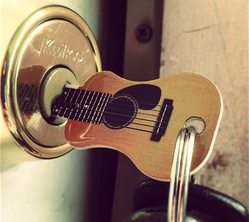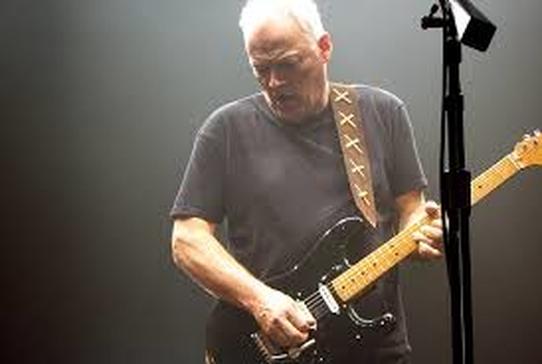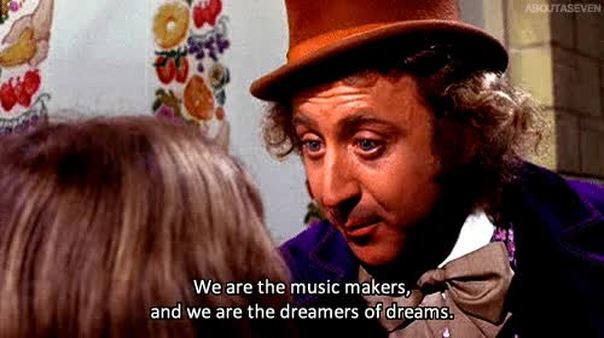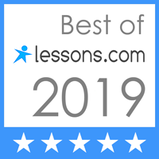|
Part 2 in my Guitar Keys series (see here for part 1)
In addition to the twelve major keys there are also twelve minor keys. Every minor key contains the same notes and chords as what is known as it's "relative major" key. (more on that topic in a future blog) Countless famous songs are written in minor keys: "Thrill is Gone", "I Shot the Sheriff", "Comfortably Numb" and "While my Guitar Gently Weeps". Here's a process you can use to calculate the diatonic chords in all twelve minor keys: 1. Pick the minor key you want to play in. 2. Write out the minor scale of that root. 3. Plug in the following chord quality pattern: minor, diminished, major, minor, minor, major, major Example: A minor scales= A - B - C - D - E - F- G chords in key of A minor= A minor, B diminished, C major, D minor, E minor, F major and G major There is a caveat in minor keys involving the fifth chord which is that they are often played as either major or dominant 7th chords. Example: in key of A minor it's common to play the E minor (the five chord) as either E major or E7. Next week - Major Keys...  not exactly what I had in mind! not exactly what I had in mind! Before answering said question, I'd like to explain some of the benefits of understanding keys... First off, it will provide you a conceptual framework so that you can begin to make sense of music. Also it will make writing, analyzing and figuring out songs/ chord progressions easier. Finally understanding keys will allow you to be more conversant with other musicians. So, what is a key? Keys are multi factorial animals, I think a good way to begin thinking about them if you're a beginner or intermediate player is to think of keys as scales, chords and arpeggios that all are built out of the same series of seven notes. Most interesting songs use notes, scales, chords or arpeggios that are "outside" of the key - this means at least one note used is not present in the major or minor scale that the key is based on but plenty of great songs don't. If all the chords in a given song/progression conform to the chords in a given key, that is called a "diatonic" chord progression. Learning the diatonic keys first is very important. ...Up next, major keys... Here is the process by which I believe music is made:
1. Your mind (your consciousness) has to think about where it is you want to move your fingers. 2. Your brain sends the impulses to manifest said finger movement. 3. Your fingers physically execute the movements. 4. Finally, a sound is produced and voila! = music If you watch great musicians playing, it appears as though whatever is in their mind somehow magically manifests in their music, and that is true, except for the "magically" part. Great musicians can in fact produce the contents of their minds/souls via their instruments but it is decidedly the result of many years of diligent practice. One of the long term goals of a musician should be to get to the point where two of the four steps in process of "mind to brain to hands to music" are eliminated. The idea is for the mind to directly go to the music, bypassing both brain and hands. Eliminating the brain is the process of putting in enough high quality practice so as to get to the point that all harmonic and rhythmic (physical) permutations are memorized and controlled by the subconscious mind. Eliminating the hands is achieved by mastering physical technique to the point where you never have any considerations like: How am I holding my pick? Am I playing on my fingertips? Am I bending my wrist enough? and so on. Two of the best ways to hasten this process are to first play without looking at your picking hand and then to refrain from looking at either hand and finally to play/practice with your eyes closed, approximately 30% of the brain is involved in vision, so when you close your eyes the acuity of your hearing goes up and your attention will be more focused. Want to discuss this more? Get in touch...  Keith Richards on rhythm Keith Richards on rhythm A common denominator off all music is rhythm/time - it's the glue that holds everything together! Developing an ability to keep solid time is surprisingly challenging. I believe it's critical for beginners to work on their rhythm with as much attention and priority as any other aspect of learning their instrument. Your main tool in this endeavor is the metronome, a device or phone/tablet application that beeps or clicks to keep the beat/time. The 4 basic rhythms (note values) I have students initially work with are: whole notes (= 4 beats) half notes (=2 beats) quarter notes (=1 beat) and eighth notes (one half beat or 2 notes per beat) Underlying the rhythm is the beat, the beat (for beginners) will be determined by the metronome. Every time the metronome clicks equals 1 beat. Once you've obtained decent proficiency with your picking and fretting hands and exercises you can set your metronome at 80 bpm (beats per minute) and play 4 picks per string across all 6 strings, beginning on string 1, progressing through all 6 strings then coming back from string 6 through string 1. Then play the same exercise with 2 picks per string. You'll play 1 note per beat, (click of the metronome) those are quarter notes. Quarter notes are the best note value to practice at first because the margin of error playing them is the lowest of any note value due to the fact that for every metronome click you hear, you play a note. Once you become proficient at this, move the metronome up to 90 bpm and repeat the process. Finally, play the same exercise with the 3 other note values. (whole, half and eighth notes) Then work on every possible permutation of the note values. Let's talk rhythm - get in touch today... |
AuthorEric Hankinson Archives
December 2023
Categories
All
|
|
The Chromatic Watch Company
(my other business) |
|



 RSS Feed
RSS Feed

